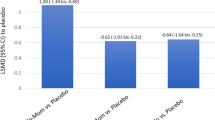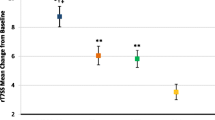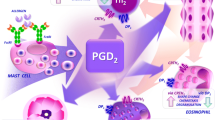Abstract
Introduction
Nasal congestion in allergic rhinitis results from tissue edema and vasodilatation in the nasal mucosa. Of the mediators released by mast cells in response to allergens, prostaglandin (PG) D2 is regarded as the most potent inducer of nasal congestion. Intranasal administration of PGD2 reproduces the nasal blockade experienced by patients with seasonal allergic rhinitis (SAR) via its action on the PGD2 (DP) receptor to induce nasal vasodilatation. Intranasal challenge with PGD2 can be a useful tool for evaluating DP-receptor antagonists.
Objective
The main purpose of this study was to examine the ability of MK-0524, a DP receptor antagonist in development for the treatment of SAR, to block PGD2 induced nasal congestion in healthy volunteers.
Methods
To this end, a double-blind, placebo-controlled, randomized, 3-period study was performed in 15 healthy subjects. During each period, subjects received MK-0524 25 mg, MK-0524 100 mg or placebo qd for 3 days. Twenty-four hours following the last dose, nasal provocations with PGD2 were performed to determine the PD75, which is the intranasal dose of PGD2 that provokes a 75% increase in baseline total nasal airway resistance as performed by active anterior rhinomanometry.
Results
Following treatment with MK-0524, the PD75 (mean±SD) was significantly shifted from 15.8 ± 18.3 μg/nostril during the placebo period to more than 512 μg/nostril both following the 25- and 100-mg (maximum challenge dose tested) dose regimen.
Conclusion
Whether this >45 fold increase in PD75 will induce a clinically meaningful effect of MK-0524 will require clinical study in participants with SAR.


Similar content being viewed by others
References
Park YJ, Baraniuk JN (2002) Mechanisms of allergic rhinitis. Clin Allergy Immunol 16:275–293
Skoner DP (2001) Allergic rhinitis: definition, epidemiology, pathophysiology, detection and diagnosis. J Allergy Clin Immunol 108:S2–S8
Doyle WJ, Boehm S, Skoner DP (1990) Physiologic responses to intranasal dose-response challenges with histamine, metacholine, bradykinin, and prostaglandin in adult volunteers with and without nasal allergy. J Allergy Clin Immunol 86:924–935
Hata AN, Breyer RM (2004) Pharmacology and signaling of prostaglandin receptors: Multiple roles in inflammation and immune modulation. Pharmacol Ther 103:147–166
Kabashima K, Narumiya S (2003) The DP receptor, allergic inflammation and asthma. Prostaglandins Leukot Essent Fatty Acids 69:187–194
Nantel F, Fong C, Lamontagne S, Wright DH, Giaid A, Desrosiers M, Metters KM, O’Neill GP, Gervais FG (2004) Expression of Prostaglandin D synthase and the prostaglandin D2 receptors DP and CRTH2 in human nasal mucosa. Prostaglandins Other Lipid Mediat 73:87–101
Sturino C, Bateman K, Berthelette C, Boyd M et al (2004) The development of MK-0524, a highly potent and selective prostaglandin D2 receptor antagonist: lessons in reactive intermediates and transporters. XVIIIth International Symposium on Medicinal Chemistry, Denmark, August
Carney AS, Bateman ND, Jones NS (2000) Reliable and reproducible anterior active rhinomanometry for the assessment of unilateral nasal resistance. Clin Otolaryngol 25:499–503
Hirschberg A (2002) Rhinomanometry: an update. ORL 64:263–267
Malm L, van Wijk RG, Bachert C (2000) Guidelines for nasal provocations with aspects on nasal patency, airflow, and airflow resistance. Rhinology 38:1–6
Wang D, Clement P (1995) Assessment of early- and late-phase nasal obstruction in atopic patients after nasal allergen challenge. Clin Otolaryngol 20:368–373
Deyo RA, Diehr P, Patrick DL (1991) Reproducibility and responsiveness of health status measures. Control Clin Trials 12:142s–158s
Bland JM, Altman DG (1986) Statistical methods for assessing agreement between two methods of clinical measurement. Lancet February 8:307–310
Ishizuka T, Matsui T, Okamoto Y, Ohta A, Shichijo M (2004) Ramatroban (BAY u 3405): a novel dual antagonist of TXA2 receptor and CRTH2, a newly identified prostaglandin D2 receptor. Cardiovasc Drug Rev 22:71–90
Ohkubo K, Gotoh M (2003) Effect of ramatroban, a thromboxane A2 antagonist, in the treatment of perennial allergic rhinitis. Allergol Int 52:131–138
Oguma T, Palmer LJ, Birben E, Sonna LA, Asano K, Lilly CM (2004) Role of Prostanoid DP receptor Variants in susceptibility to Asthma. N Engl J Med 351:1752–1763
Author information
Authors and Affiliations
Corresponding author
Rights and permissions
About this article
Cite this article
Van Hecken, A., Depré, M., De Lepeleire, I. et al. The effect of MK-0524, a prostaglandin D2 receptor antagonist, on prostaglandin D2-induced nasal airway obstruction in healthy volunteers. Eur J Clin Pharmacol 63, 135–141 (2007). https://doi.org/10.1007/s00228-006-0211-2
Received:
Accepted:
Published:
Issue Date:
DOI: https://doi.org/10.1007/s00228-006-0211-2




